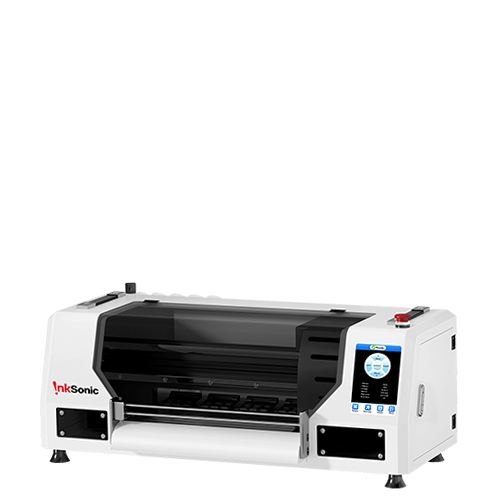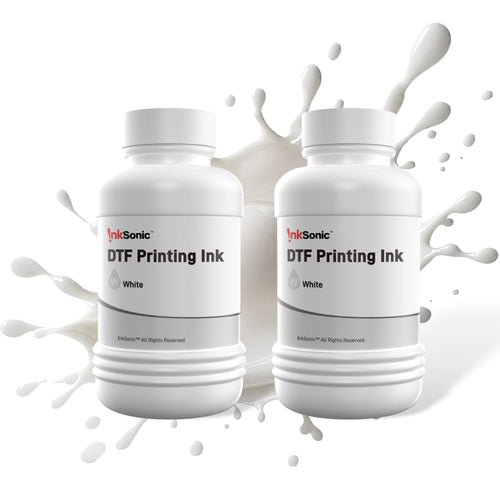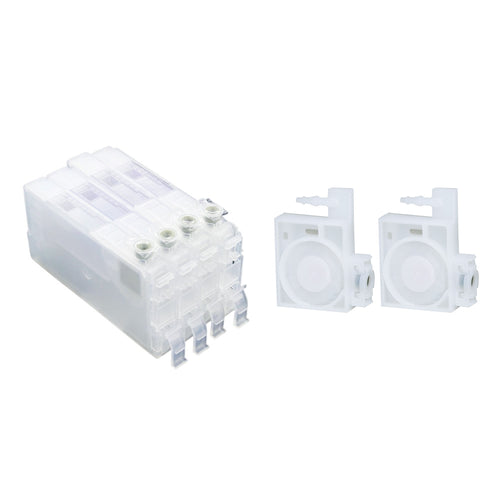One day, you suddenly realize your DTF printer is no longer as responsive and efficient as it was on day one. Just like people, printers need care—minor issues, if left unchecked, can sometimes disrupt your entire workflow.
You may have typed countless keywords into search engines, jumped from one site to another, and tried all kinds of methods—yet the problem remains unsolved. But now, you don’t need to keep searching.
This article categorizes the issues into two types: those that users can troubleshoot themselves, and complex faults that require professional technical support. Regardless of the issue, you’ll find the solution at InkSonic.
Tip: Please troubleshoot in the order listed below.
DTF Printer Poor Printing Performance Solutions
DTF Printing Color Deviation


Main Symptoms:
DTF printing results show colors are too thin, or colors that should be red are printed as white, or appear as a mixture of multiple colors.
Solutions:
Print Colors Too Faint:
Have you changed the ink brand? Be sure to use original consumables matched to the DTF printer, because different ink brands have varying formulations. Parameter mismatches can cause color deviations.
Have you adjusted the ink settings? Please check whether the white ink concentration is set to 100%. It is recommended to create a spot color image and use spot color printing.
The printer may not have been used for a long time, causing white ink to settle and color ink to deteriorate.
If the issue is still not resolved, please contact the InkSonic team for assistance with color adjustment.
Ink Mixing in Printed Patterns:
If the printed colors are reversed, it may be due to incorrect ink sac installation. Reinstall them correctly.
If ink mixing occurs, it is mostly caused by ink backflow, usually due to a problem in the white ink circulation system. Such issues are recommended to be handled under the guidance of InkSonic’s professional team.
DTF Printing Uneven Or Blurry

Symptoms:
Blurry prints, visible lines, grainy images
Solutions:
Check the resolution of the original image. It is recommended to be at least 300 dpi, and it can be adjusted in Photoshop.
Check whether the ink in the ink tank is more than half full to ensure a sufficient ink supply; at the same time, observe whether there are air bubbles in the ink tubes.
Use the software to clean the nozzles. Then, slowly extract waste ink from the waste ink tube using a syringe, and gently wipe the bottom of the print head with a lint-free cloth. After that, reprint the image and observe whether it returns to normal.
Adjust the following items in the print settings one by one: increase the print resolution, switch from bidirectional printing to unidirectional printing, increase the number of passes (exclusive function of InkSonic U13), and enable feathering (exclusive function of InkSonic U13). After each adjustment, it is recommended to print a test image.
Note: With the above high-precision settings, the printing speed may be slightly reduced, but you will get higher-quality printing results.
DTF Ink Spray Splattering


Symptoms:
Ink splashes, unclear color output
Solutions:
Finding out which color is affected. And cleaning the print head using by driver software.
Slowly extract waste ink using a syringe, and gently wipe the print head with a lint-free cloth.
Putting nozzle cleaning liquid into the ink station top, back the carriage so the print head overlaps the ink station top (soak for a while), then print a test image.
Adjust the DTF print head height (not recommended to do on your own).
If unresolved, contact the InkSonic after-sales team.
Ink Dripping On A DTF Print Head
Solutions:
Click "Clean Print Head" in the software, then extract waste ink. For InkSonic devices with a one-click ink fill button, use it directly. Wipe the print head and cleaning station wiper with a lint-free cloth.
InkSonic U13 Users:
Check if the cleaning unit wiper works properly and moves fully.
Remove the ink sac and check for drips. If dripping, replace the ink sac. If still dripping, the print head may have an internal perforation—contact InkSonic support.
Ink Flowing On Transfer Film

Symptoms:
Ink spreads or overflows on the transfer film
Solutions:
Ensure the rough side of the DTF film is facing up and in contact with the ink; if reversed, replace with a new film.
For InkSonic C13/E13, reduce the ink volume of related colors in the software settings (skip for Inksonic U13 users).
Check if the preheating plate is enabled. In cold environments, consider using an air conditioner or extending drying time.
White & Color Ink Misalignment


Symptoms:
White edges around images, misalignment between white and color layers (vertical/horizontal)
Solutions:

White edges:
- Ensure the resolution of white and color ink layers matches.
-
Adjust shrink parameters in RIP software:
InkSonic U13: set between 0.3–0.5
Other models: set between 1–2px
Misalignment:
Check if the white and color layer resolutions are consistent.
Clean the encoder stripe and ensure it’s dust-free. How to check the encoder stripe
Check if the encoded stripes disk is properly attached; correct if necessary (with InkSonic guidance).
Adjust paper feed belt tension if too tight/loose (with InkSonic guidance).
DTF Print Head Scratching Film

Symptoms:
Noticeable scratches on the transfer film
Solutions:
Ensure the film is laid flat. For InkSonic devices, turn on the printing platform.
If equipped with a paper pressing roller, check the installation and clean the pressure wheels.
Check if the film is damp—replace with dry film if needed.
If the distance between the film and print head is too close, adjust head or platform height (with InkSonic guidance).
DTF Printing Result Doesn’t Match Original




Symptoms:
Incorrect image size, stretching, missing parts
Solutions:
Replace the print file, ensuring 300 dpi resolution.
If the image is stretched, clean encoded strips disk.
If the output size is smaller than the software setting, set the canvas to 8.268 inches (for A4-size machines).
If elements are missing, check that the original image is complete and set the canvas margin to 0.
DTF Printing Speed Turn Slow
Symptoms:
Slow carriage movement
Frequent interruptions
Poor print quality (stripes, uneven color)
Solutions:
Use a lint-free cloth with sewing machine oil to wipe carriage rails, then print a test image.
Let the printer rest, then test again. If unresolved, consider replacing the carriage motor.
Daily Tip: Regularly lubricate guide rails, print with the cover open to avoid ink buildup.
More details: Why is the DTF Printing Speed Turning Slow?
General Solutions for DTF Printing Not Good
If print quality is poor but not due to the above issues, follow this initial troubleshooting process:
Suggested steps:
Print a nozzle check pattern
Print a complete design
Print another nozzle check to compare and identify improvements
Based on the results, issues may include:
White ink prints, but no color ink:
Check that the color ink cartridges and ink tanks are full. If not, fill them.
Ensure color ink sacs are tightly inserted (use paper to secure if needed).
Clean the print head and print test strips.
Color ink prints, but no white ink:
Check that the white ink cartridge and the ink tank are full. Refill and recheck.
Clean the print head and print head check.
The following steps should only be done under InkSonic guidance:
If test lines are abnormal, extract waste ink and wipe the print head bottom with lint-free cloth and cleaning solution.
Soak the print head in cleaning solution for ~20 mins, then clean and test.
If no improvement, flush manually or replace the print head.
No color output at all:
Contact InkSonic technical support.
The test pattern is distorted, or the lines are offset:
Shut down immediately, remove the print head, clean the print head cables, reboot, and retest.
If still, the print head may be damaged. Use a multimeter to test the motherboard fuse (under InkSonic guidance).
Daily Maintenance & Prevention
Clean the print head lightly before startup and after finishing a job. Do a deep clean if unused for over a week.
Let the printer rest after 4 hours of continuous work.
Always use high-quality ink and compatible transfer films.
Don’t modify print settings arbitrarily.
Keep the workspace clean, away from water, and at ~40% humidity.
Pro Tips to Boost Print Performance
- Enable flashing spray mode: Keeps the print head moist and prevents clogs during large white ink or detailed prints.
- Enable feathering mode: Softens color transitions and edges—ideal for portraits, gradients, and textures. U13 supports high-precision feathering.
- Use vacuum platform & heating plate: Holds film flat and preheats surface to accelerate ink drying and reduce ink spread.
- Calibrate print settings regularly: Check color consistency, size accuracy, and white/color alignment weekly or before large batches.
- Set appropriate Pass count:
- Normal design: 4 Pass
- Detail-rich images: 6 Pass
- Ultra HD prints: 8 Pass or more
Conclusion
Poor print quality isn’t the end of the world. The key is timely identification and applying the right solution. Don’t neglect daily maintenance or rest periods—because your printer, like people, needs proper care and attention.
If your DTF printer isn’t performing well, this all-in-one guide covers the most common problems and how to fix them—no need to search all over. Leave the troubleshooting to InkSonic.
































